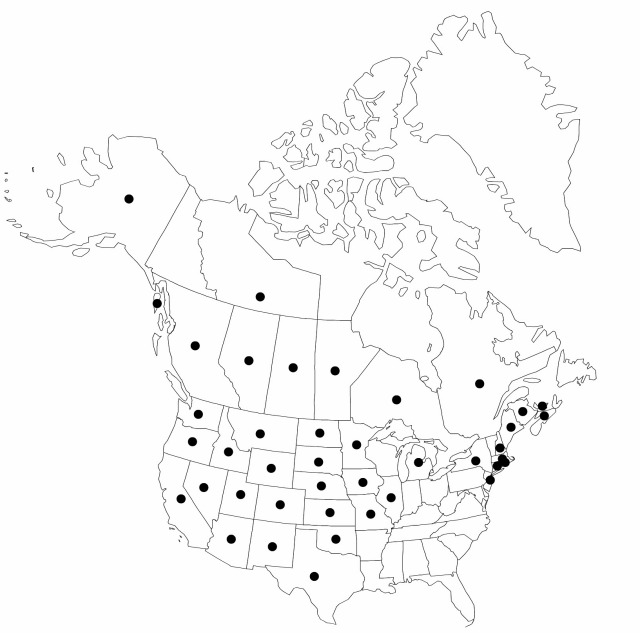Bolboschoenus maritimus
in W. D. J. Koch et al., Syn. Deut. Schweiz. Fl. ed. 3, 3: 2531. 1905.
Culms 50–150 cm × (1–)3–8 mm. Leaves: sheaths reaching ± to mid culm, fronts usually membranous at mouth, apex concave to convex, veins diverging proximal to summit leaving triangular, veinless area (often disintegrating); widest blade 2–12 mm wide. Inflorescences with all spikelets sessile, simply branched with not more than 1/2 of spikelets solitary or in clusters of 2–10 on 1–4 rays, rays not exceeding 8 cm; involucral bracts that surpass inflorescences 1–4, widest bract 1–6 mm wide. Spikelets (1–)2–40, ovoid to lanceoloid, 7–40 × (4–)7–10 mm, base usually cuneate to rounded; scales often loosely imbricate, bright orange-brown to stramineous, often obscurely lineolate-spotted, 5–8 × 3–4 mm, membranous, translucent, apex acute, 2-fid 0.5–1 mm deep, awn slender, 1–3 × 0.25 mm at base. Flowers: perianth bristles not persistent on shed achenes or sometimes 1–few weakly persistent, medium brown, to 1/2 achene length; anthers yellow, very rarely orange, 2–4 mm; styles 2–3-fid. Achenes medium to dark brown, rarely yellowish or whitish, obovoid, biconvex, or concave-sided, rarely obtusely compressed trigonous, 2.3–4.1 × 1.9–2.8 mm, apex rounded to nearly truncate, beak 0.1–0.4 mm, surface glossy, exocarp (epidermal) cells usually clearly visible at 10–20X; in achene cross section exocarp 2 times as thick as mesocarp, its cells greatly enlarged, at least 3 times deeper than wide; achene specific gravity much less than water.
Distribution

Alta., B.C., Man., N.B., N.S., N.W.T., Ont., P.E.I., Que., Sask., Alaska, Ariz., Calif., Colo., Conn., Idaho, Ill., Iowa, Kans., Maine, Mass., Mich., Minn., Mo., Mont., N.Dak., N.H., N.J., N.Mex., N.Y., Nebr., Nev., Okla., Oreg., R.I., S.Dak., Tex., Utah, Wash., Wyo., Mexico, South America (Argentina, Peru), Eurasia, Africa, Pacific Islands (Hawaii).
Discussion
Subspecies at least 2 (2 in the flora).
Bolboschoenus maritimus belongs to a difficult, worldwide complex, in which the delimitation of specific and infraspecific taxa is still unclear. The new lectotype and epitype from the Baltic coast of Sweden selected by S. G. Smith and I. Kukkonen (1999) are used here as the basis for redefining B. maritimus subsp. maritimus, which was previously defined to include B. yagara (Ohwi) Y. C. Yang & M. Zhan (J. Browning et al. 1996; Z. Hroudová et al. 1998).
It seems likely that some populations of both Bolboschoenus maritimus subsp. maritimus and B. maritimus subsp. paludosus have been introduced into the flora from Eurasia.
Putative Bolboschoenus maritimus × B. robustus hybrids are common in zones of sympatry along the northern Atlantic Coast and in California, putative B. fluviatilis × B. maritimus hybrids occur in California, and many B. glaucus × B. maritimus hybrids occur in California and Idaho (J. Browning et al. 1995). They are intermediate between their putative parents in every character studied and are often fertile. Interspecific hybridization is probably responsible for much of the infraspecific variation in B. maritimus, especially along the northern Atlantic and California coasts. The orange anthers and few 3-fid styles on some specimens from southeastern Texas may be due to introgression from B. robustus. The type of Scirpus maritimus forma agonus Fernald is probably a B. maritimus × B. robustus hybrid.
Bolboschoenus maritimus and B. robustus have been widely confused in the southwest, where some authors (e.g., H. L. Mason 1957; P. A. Munz 1959, 1968) have treated B. maritimus as a synonym of B. robustus, and others (D. S. Correll and H. B. Correll 1972) have treated B. robustus as B. maritimus var. macrostachyus Michaux.
No acceptably vouchered chromosome counts for Bolboschoenus maritimus are available from North America. The voucher for the 2n = 90 count by N. A. Harriman (1981) from southeastern Texas is a mixed collection of B. maritimus subsp. paludosus and B. robustus. Reasonably reliable chromosome numbers reported for B. maritimus in Europe are mostly 2n = 108 or 110, but vary from 2n = 55 to 112 (V. Jarolímová and Z. Hroudová 1998).
Selected References
None.
Key
| 1 | Styles all or mostly 3-fid; achenes obtusely compressed trigonous or some biconvex in same spikelet; scales dark to medium brown; achenes dark to medium brown. | Bolboschoenus maritimus subsp. maritimus |
| 1 | Styles all or mostly 2-fid; achenes mostly biconvex; scales dark to medium brown to stramineous or nearly colorless; achenes mostly medium brown, sometimes darker or paler. | Bolboschoenus maritimus subsp. paludosus |